Training, Workshops, and Seminars
This page is under Construction
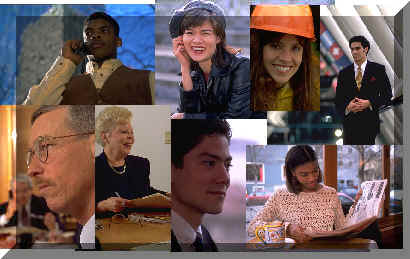
On this page are some of the examples of the types of custom training we provide. The workshops are placed in a wholistic business approach. For your organization to truly be a well oiled machine, then all parts should work together. Your training program should reflect your company as a system, not a bunch of parts thrown together.
All events are customized to fit your particular organization's requirements. Training is only the first step. We can also facilitate your efforts to implement changes. In our workshops we consider a Christ-centered approach to business along with the best writings in management thought.
| "...Your presentation, "Managing Work Force
2000" was outstanding...........reports form the conference
evaluations indicate that your remarks were very well received."
|
Some Choices :
- Workshops/speaking Only: Decide on one specific training course, workshop, or subject for a speaking engagement. or
- Training Support: Decide to have us support your training program. Here the first step is a needs assessment. We work with you and your people to decide on what training is best for you and the specific style, data, and types of information we should address. We may also help design the processes and flow of the training program itself.
- Teaming With A University: Team with one of several Universities and EN-TECH/Westbrook Stevens, LLC to provide even more credibility and depth.
- Contract Out Your Training Department: Let us run your training program for a savings in your overall training cost.
Modules for A Wholistic Approach to Training Development
Below is an example of a set of workshops designed around the Five Phases on the Linked Management Models. Each phase is designed to help your organization answer different questions.
-
How can we get the best results from our people? Phase 1: The Attributes of Excellent Management.
-
How can we understand and navigate through Chaos? Phase 2: Managing The Storms of Chaos.
-
How Can We Understand the Effects of Change and/or Chaos on Our Organization? Phase 3; The Drivers of Change Model.
-
What should we consider when we plan? Where do we focus our efforts to get the biggest bang for the buck? Phase 4: Systems Thinking and Development.
How do we maximize the good and minimize the bad when going through a change? Phase 5: The Three Phases of Change
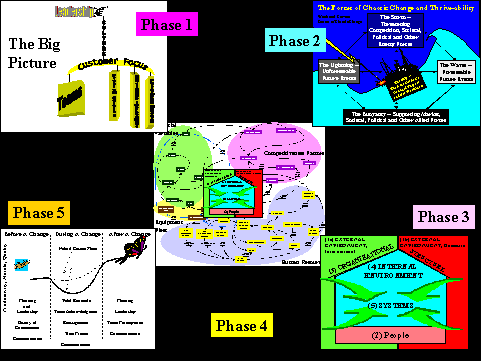
10.00: Phase 1: The Attributes of Excellent Management
How can we get the best results from our people?
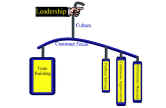
The symbol for Phase 1 is a mobile in balance. It features The Seven Elements of Excellent Management.
- Building Leaders
- Developing a Winning Culture
- Focusing on the Customer
- Team Building (People Working Together)
- Problem Solving (Skills Enhancement)
- Continuous Improvement (Change Management)
- Performance Measures.
Remove any one piece and it is out of balance. Based on many years of research this set of workshops can be delivered in a number of ways and includes the following types of training. More detailed workshop designed around the seven attributes are below.
10.10.00: Building Leaders Phase 1, Attribute 1: Effective Leadership.
10.10.10 Everyone has to Lead
Leadership Defined,
People Skills and Respect
Assertiveness/Speak-up
10.10.20 Leadership 101, How To Get Results — Motivating, Coaching and Counseling. Using the concept found in the Westbrook Stevens Attributes of Excellent Management and good task and project management learn how to get results and improve organizational success.
Throwing out the Old and Bringing in The New (Use of Power),
What Does Good Leadership Look Like (Science of Leadership, Styles, Motivation, Productivity)
What Does Our/My Leadership Look Like (Personal Needs Assessment)
What Do We Need to Change (Making a Plan)
How Can We Change (Changing)
10.10.30 Leading and Motivating People — Most leaders say they understand that “people are our most important asset”. That is more true, but do we act that way? Organizations may use high technological processes but even these are dependent on the work force. The knowledge and the potential to learn is the most valuable asset of a high tech organization. The term “knowledge worker” defines those employees who work largely with their minds, not their hands. It is critical that organizations understand how to motivate this type of employee. Research has shown that the attitude of such workers is critical to their productivity. This seminar includes motivational concepts tailored specifically for the knowledge worker as well as those for the most basic skills. Attendees may use games, comparisons of theories and working life, and case studies to develop strategies for identifying unmotivated knowledge workers and approaches for dealing with them. Dealing with the current highly motivated knowledge worker will also be discussed. It is important that they maintain their positive contributions and serve as role models and mentors for others.
10.10.40 Ethical Leadership
10.10.50 Building Leaders and Empowerment
Leadership Defined
Everyone Has to Lead
Finding Committed Candidates
Respecting People
Incubating Leaders
What is Empowerment
Empowerment and Maxwell 21 irrefutable laws of leadership
Steps to Empowering
Incubating New Leaders
Leadership Styles, Motivation, Coaching, and Productivity
Assertiveness/Speak-up
Creating a Shared Vision
Understanding (SMART) Goals
10.20.00 Developing a Winning Culture Phase 1, Attribute 2: Building a Winning Culture.
10.20.10 Organization Culture — Organization Culture is a concept with which most are familiar but most have problems with implementing an effective strategy. Culture is developed over time and significant time is required to change it. Culture includes norms of the organization, rites and rituals and symbols and myths. Culture dictates the pace that the organization expects to accomplish goals and how its processes function. In order to increase productivity, frequently the culture must be changed. The existing culture must be clearly identified and new elements replace the old elements that serve to hold back the organization. Attendees will use the Organization Culture Assessment Instrument, recently developed, to measure organizational culture. Attendees will develop a plan that can be used as a draft to start the culture change process in a selected organization unit.
10.20.20 Comic Vision and the Bottom Line -- Find out why thousands of Fortune 500 companies and organizations are realizing the positive impacts of embracing humor. Learning your own style of humor along with your co-workers will allow you to bring more to work each day. See the benefits of humor and how it can improve morale, decrease turnover and absenteeism, and increase productivity. Several case studies will be discussed and opportunities to apply them “back home” will be abundant.
10.20.30 Building An Effective Organizational Culture
Understanding The Difference Between High and Low Productive Cultures (based on great writings on culture)
Building An Effective Culture
Managing Conflict
Celebration and Fun Work Environments
10.20.40 Fish Camp (all about attitude)
10.20.50 Painting Camp (all about creativity)
10.20.60: Developing and Communicating Vision, Goals, and Strategies
10.20.70
10.30.00 Focusing on the Customer Phase 1, Attribute 3: Building an Excellent Customer Relations.
10.40.00 Team Building and People Working Together: Phase 1, Attribute 4: Building Excellent Teams10.30.10 Customer Relationships — We have developed a three module approach to Customer Service. First learn about the external customer and what you can do to delight them. Then build on this information with understanding the internal customer and those people on our team that can make all the difference. Then learn how to manage your organization’s “customer focus” to become more successful.
10.50.00 Problem Solving and Skills Enhancement, Phase 1, Attribute 5: Filling The Teams' Tool Boxes.

10.50.10 Problem Solving Tools and Methods — A must for teams who want to do great things.
10.50.20 Presentation Skills — One of the many problems industry faces is the lack of their key people’s ability to present ideas. We have a solution with a set of workshops:
10.50.20.10 “Presentation Skills for Professionals” -- This hands-on course covers the essentials for successful presentations. Individual skills are baselined up front and then applied during a closing mini-presentation. Critique is offered from instructor and peers. Specific areas of concern, including content, mechanical (A/V use), and delivery techniques will be covered and applied. Special emphasis on credibility building will be offered, along with tools to make your presentations more involving, utilizing a variety of tools that go beyond just your voice and overheads.
10.50.30.20 Presentation Skills for Technical Professionals -- This workshop offers the same structure as Presentation Skills for Professionals, with a strong emphasis on presenting technical issues to a broad spectrum of audiences, including senior management, professional groups, and other non-technical types on the receiving end of your presentation. The course will show you ways to go beyond boring charts and formulas and bring your information to life with lively anecdotes, analogies, examples and audience involvement techniques.
10.50.40 Facilitation Skills
10.50.50 Project Management this link (when completed) will take you to a series of Project Management workshop for the University of Phoenix — Along with the American Management Association’s (AMA) courses that can be provided through the AMA, we also have a set of project management programs that can be designed to fit your needs.
Understanding and Developing a Project Management Systems
Conceptual Design Phase
SMART Goals
Team Building
Scope Management
Planning Phase
Flow Charting
Network Diagramming
Gantt Charts
PM and PERT
Budgeting
Scheduling
Implementation Phase
Team Work
Productive and Quality Work
Tracking Progress
Transition and Close-out Phase
Operations and Maintenance Phase
10.50.60 Project Management – Beyond the Techniques -- Anyone can learn how to develop and use a Gantt chart and other diagrams in about an hour. However, if they don’t have an integrated, phased approach understanding to project management, charts and other tracking methods are useless. By understanding the required data gathering that must follow each project’s lifecycle, this course gives you the framework and tools to not just set up a good project, but to use techniques such as Earned Value to see how your project’s overall work efforts are paying off along the way. People skills will also be covered in depth, helping you better understand the PM success phrase: “Take your project seriously; take yourself lightly.”
10.50.80 Time Management
10.50.90 Value Engineering
10.50.100 Manufacturing Supervisor, Development Production Reporting and Efficiently Controls
- Daily Production Reporting
- Efficiency Control Systems
10.60 Continuous Improvement and Change, Phase 1, Attribute 6.
10.70 Performance Measures, Phase 1, Attribute 6: Measuring Results. Performance Measures — This is a easy to follow seven step process to developing useful performance metrics.
10.70.10 Production Control Standards Development
10.70.20 360 Degrees Performance Evaluation
10.70.30 Steven Steps to Performance Evaluations
Step 1: Know the Rules
Step 2: Know the Goals
Step 3: Selecting The Criteria Related to the Goals
Step 4: Selecting the Performance Indicators Related the Criteria
Step 5: Collecting the Data
Step 6: Analyzing the Data
Step 7: Using the Data
20.00 Phase 2: The Storms of Chaos Model
How can we understand and navigate through Chaos?
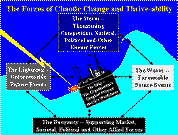
This phase is all about Strategic Planning. The symbol is a ship on a stormy sea. Phase 2 is made up of five elements.
- Waves of Trends,
- Buoyancy of Supporting Relationships,
- Lightning of the Unexpected Events,
- Enemy Storms, and
- Your Ship.
Based on many years of research this set of workshops can be delivered in a number of ways. More details about each element follows.
20.10 Trends of Waves, Phase 2, Element 120.20 Lightning of the Unexpected Events, Phase 2, Element 2
Forecasting Trends
Empowering Gate Keepers
20.30 Buoyancy of Supporting Relationships, Phase 2, Element 3
Predicting Risk
Contingency Planning
Risk Management
20.40 Enemy Storms, Phase 2, Element 4
Understanding Supportive Relationship
Building Business Relationship
Building Social Relationships
20.50 Your Ship, Phase 2, Element 5
Competition and Public Relations
Understanding Competition
Understanding Negative Social Pressures
Understanding Other Negative Pressures
Fighting the Enemy
Designing Your Organizational Ship
Improving the Sea Worthiness of Your Organizational Ship
20.50.10 Organizational and Technological Strategy
Competitive strategy is being driven by a combination of the rate at which technology is developing and the information revolution. These factors are being translated into global strategies that affect every country and organization. This seminar includes classical models and strategies to global models with resulting strategic alternatives. Typical organizational goals and characteristics will be developed by the attendees and appropriate strategic alternatives will be developed for analysis and consideration.
30.00 Phase 3: Understanding the Drivers of Change
How Can We Understand the Effects of Change and/or Chaos on Our Organization?

This phase is all about understanding what drives change and how we can better forecast change in our organization. Five elements make up this model:
- The External Environments (a. International and b. Domestic)
- People
- Organizational Structure
- The Internal Environment
- The Systems that make up the company/organization
More details follow:
30.10 The External Environment, Phase 3, Element 130.20 The People, Phase 3, Element 2
International Environment
Domestic Environment
Local Environment
30.30 The Organizational Structure, Phase 3, Element 330.30.10 Employee Motivation
Great Theories of Motivation and Behavioral Science
Low Producing Environments
High Producing Environments
101 Motivating Alternatives
30.20.20 Intra-Preneurship: Creativity, Innovation and Taking Personal Risk On Behalf of the Company
30.20.30 Coping with Stress; One that everyone likes.
30.20.40 Roles and Responsibilities and Expectations
30.20.50 Building Core Competencies and Human Resources
10.20.60 introduction to HR Laws, Polices, Procedures, and Company Regulations
10.20.70 The Family and Medical Leave Act (FMLA)
Employee Eligibility
Required notices
Preventing abuse
Critical Issues under the FMLA
Vacation, sick days & other work benefits
"Equivalent job and salary"
When it is and isn't legal to hire a replacement:
Enforcing Attendance Policies and Other Work Rules
What to do about Attendance problems and the FMLA:
How to discipline employees and avoid retaliation claims
How to handle termination
10.20.70 Training People (Train the Trainer for Supervisors)
Introduction to Training
Supervisors' Responsibilities in Training
Activity Based Training
Standard Operation Procedures
Level of Training
Monitoring and Validating
Cross Training
Training Aids
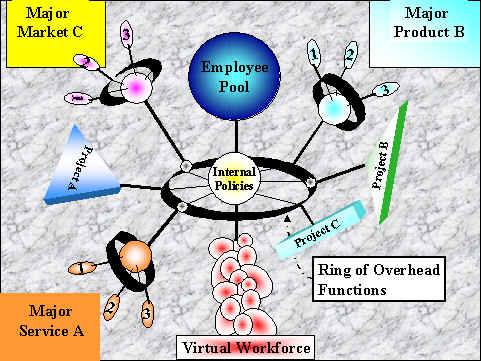
30.40 The Internal Environment, Phase 3, Element 430.30.10 The Organizational Structure of the 21st Century — The design of an organization structure incorporates characteristics of the environment, the work force and organizational goals. The environment may be relatively static, changing predictable of changing chaotically. The level of technology that it must accommodate and its demographics characterizes the work force. The structure allows the organization to meet its goals by communicating through the selected structure. This seminar will match typical environment conditions and technology level with typical supportive strategies. Attendees will develop a model of the host organization’s characteristics and develop a structure that best meets the demands of that organization. Also, attendees will examine current structures and determine the environment in which it should meet organization goals.
Organizational Types
Organizational Design and Fit Issues
Future Structures
30.50 The
Systems, Phase 3, Element 5
30.50.10 Budget Formulation
and Financial Systems 30.50.20 Understanding
Systems and Reactions to Change 30.50.30 Human Resources
Systems 30.50.40 Processes and
Operations 30.50.50 Business and
Management Systems
40.00 Phase 4: The Business/Organization as a System
What should we consider when we plan?
Where do we focus our efforts to get the biggest bang for the buck?
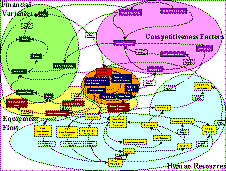
This phase is all about understanding how your organization works as a systems and designing a plan of action. The symbols used here are traditional systems loops.
40.10 Organizational Systems Thinking — How does the entire organization and everything else work together? An organization is composed by interrelated system functioning either sequentially, in parallel and both. Organizational productivity is determined by how effective these systems interact. This seminar uses the concepts found in The Fifth Discipline, by Peter Senge, The Goal by Eliyahu Goldratt and case studies. Most organizations have systems that are acting against the interest of the organization as a whole, independently in its own interest or without value to the organization. Attendees will identify a group of systems and assess the effectiveness of the systems and their interrelationships.
Open and Closed Systems,
The Systems Loops and The Laws of Systems Thinking
Processes and Root Causes
Planning and Project Management
Open and Closed Systems
Systems Loops
Systems Laws
50.00 Phase 5: The Three Phases of Change
How do we maximize the good and minimize the bad when going through a change?
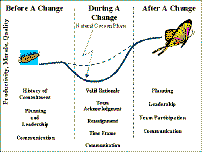
This phase is all about mastering change. The symbols used here the stages of a metamorphoses from a caterpillar into a butterfly. There are three phases to any change.
- Before the Change
- During the Change
- After the Change
More detailed workshops follow:
50.10 Change Management,
-
First Stage of Change (Caterpillar Stage), Before the Change
-
Second Stage of Change (Cocoon Stage), During the Change
-
Third Stage of Change (Butterfly Stage), After the Change
50.20 Understanding the Types of Change: Chaotic Change — Where to you place your efforts and spend your resources. Planned Change — All that is planned will still have issues to manage. The Drivers of Change When things happen how can we plan for and react to the chain reaction of future events.
50.30 — A start to finish approach to getting results.
50.40 Configuration Management
100.00 Other Types of Training: Faith Based, Non-Profits, and Motivational.
100.10 Capacity Building Workshops The Capacity Building Workshops are designed to provide a foundation for faith-based non-profit organizations. During these highly facilitated workshops, organizations are lead thought a series of phases from ministry vision, to obtaining grants, to program operations.
100.20 Business Bible Study - A forty-hour set of workshops designed around the linked management models and your organization's needs. One way to teach this is as a one hour a week bible study.
100.30 Motivational Presentations — Humor — Building Morale Through Comic Vision — Humor and the Corporate Bottom Line — Take Your Project Seriously and Yourself Lightly — Many times we are asked to provide a fun motivational speech, sometimes using music and humor.